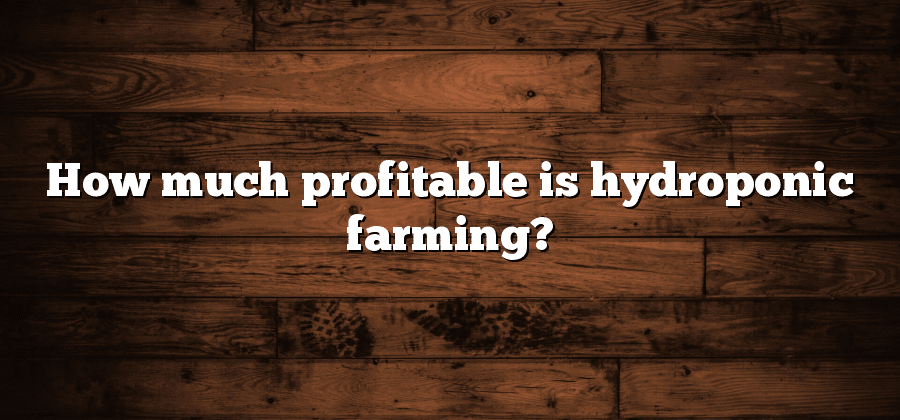Advantages of Hydroponic Farming
Hydroponic farming has gained significant popularity in recent years, and for good reason. One of its biggest advantages is its ability to save water. Traditional soil-based farming requires a large amount of water to nourish the crops, and much of it goes unused as it seeps into the ground. In hydroponic systems, water is recirculated and can be reused, resulting in significant water savings. This not only helps conserve this precious resource but also reduces the strain on local water supplies.
Another advantage of hydroponic farming is its ability to grow crops in areas with limited arable land. With traditional farming methods, the availability of suitable land is often a limiting factor. However, hydroponic systems require minimal space and can be set up indoors, in greenhouses, or even in urban settings. This makes it possible to grow fresh produce in urban environments where traditional agriculture would be impractical. Additionally, hydroponic farming allows for year-round cultivation, making it possible to have a steady supply of fresh produce irrespective of seasonal changes.
Types of Crops Suitable for Hydroponics
Types of Crops Suitable for Hydroponics
Hydroponic farming offers a unique and innovative way to grow crops without soil. With this method, various types of crops can be cultivated successfully, leading to a diverse range of agricultural possibilities. Leafy greens, such as lettuce, spinach, and kale, are particularly well-suited for hydroponics. Their shallow root systems and high water content make them thrive in a nutrient-rich water solution. Herbs, like basil, mint, and parsley, also flourish in hydroponic systems due to their compact size and ability to adapt to different growing conditions.
In addition to leafy greens and herbs, certain fruiting crops can also be grown using hydroponic techniques. Strawberries, tomatoes, and peppers, for example, can be successfully cultivated in hydroponic systems with the right balance of nutrients, light, and temperature. These crops typically require a larger and more sophisticated hydroponic setup, as they have deeper root systems and higher nutrient demands. However, the controlled environment provided by hydroponics allows for year-round production and consistent, high-quality yields.
Costs and Investments in Hydroponic Farming
Hydroponic farming offers numerous advantages, including increased crop yields, water conservation, and the ability to grow crops in limited spaces. However, like any agricultural practice, hydroponics requires initial investments and ongoing costs. These expenses can vary depending on factors such as the scale of the operation, the chosen hydroponic system, and the types of crops being grown.
One of the primary investments in hydroponic farming is the setup of the growing system itself. This includes purchasing or building infrastructure such as greenhouse structures, tanks or trays for nutrient solutions, pumps, and grow lights. The initial setup costs can be substantial, especially for larger operations with advanced technology. Additionally, ongoing costs for hydroponic farming include the purchase of nutrient solutions, electricity to power the grow lights and pumps, and regular maintenance of the system to ensure its efficient operation. These costs, although necessary, should be carefully considered and budgeted for when venturing into hydroponic farming.
Increasing Crop Yields with Hydroponics
Hydroponic farming has revolutionized the way crops are grown, specifically in terms of increasing crop yields. This innovative system eliminates the need for soil by providing plants with a nutrient-rich water solution, resulting in faster and more efficient growth. One of the primary reasons why hydroponics boosts crop yields is its ability to provide plants with optimal conditions for growth. By supplying plants with the exact nutrients they need, farmers can ensure that their crops are getting the necessary elements for healthy development. Additionally, the controlled environment of hydroponic systems allows for the manipulation of factors such as temperature, humidity, and lighting, all of which can further enhance crop yields. These precise adjustments create an ideal growing environment, maximizing the plant’s potential to produce higher yields.
Environmental Benefits of Hydroponic Farming
Hydroponic farming, a method of cultivating plants without soil, offers numerous environmental benefits. Firstly, this innovative farming technique requires significantly less water compared to traditional soil-based farming. This is because the water used in hydroponics is recycled and can be reused multiple times, reducing water consumption and minimizing strain on freshwater resources. Additionally, hydroponic systems eliminate the need for chemical pesticides and fertilizers, as the nutrient-rich water solution provides plants with all the necessary nutrients they need to grow, reducing the risk of soil and water contamination.
Furthermore, hydroponic farming has the potential to reduce land degradation and deforestation. With this method, plants can be grown vertically in a controlled environment, allowing for higher crop density. As a result, less land is needed to produce the same amount of crops compared to traditional farming methods. This leads to preserved natural habitats, less deforestation, and protection for wildlife. Moreover, the controlled environment in hydroponics minimizes the risk of crop diseases, reducing the need for land clearance and chemical treatment that can harm the ecosystem.






